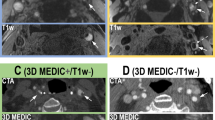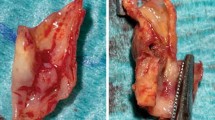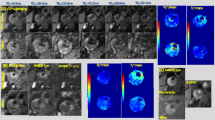Abstract
To evaluate ultra small superparamagnetic iron oxide particles (USPIO) enhanced magnetic resonance (MR) imaging for characterization of atherosclerotic carotid plaques by assessing vascularity and plaque inflammation, besides contrast-enhanced MR angiography (CE-MRA) of the carotid artery stenosis. Twelve patients with severe carotid artery stenosis, scheduled for endarterectomy, underwent MRI of the carotid artery bifurcation using SHU 555 C at a dose of 40 μmol Fe/kg BW. The MR imaging protocol comprised pre- and post-contrast T2*-w, a first-pass CE-MRA and dynamic T1-w sequences. For quantitative data analysis, the signal intensities (SI) were measured and SNR-data (SNR = SIblood/plaque/bone marrow/standard deviationnoise) as well as ΔSI-data (SNRpost–SNRpre) were calculated. In addition, two radiologists rated the diagnostic performance of first-pass MRA according to a four level decision scale. Staining of anti-dextran (SHU 555 C) and anti-CD68 (macrophages) was performed for immunohistological confirmation. Plaque sections with a T2*-w signal decline (intracellular USPIO accumulation in macrophages) showed significantly changes (mean −14%, 95% CI, −5 to −20%; P < 0.01) and corresponding plaque regions had significantly higher (15.15 ± 1.76 vs. 5.22 ± 1.50; P < 0.01) T1-w enhancement data (global estimation of vascularity). The first-pass MRA of the supra-aortal vessels provided images of diagnostic quality. Representative immunohistology sections revealed colocalization of dextran- and CD68-immunoreactive cells. USPIO-enhanced MRI is feasible for in vivo assessment of vascularity and macrophage content in atherosclerotic carotid plaques, determining an association of these potential imaging biomarkers of plaque vulnerability. Diagnostic MRA of the supra-aortal vessels can be imaged additionally with a single administration of SHU 555 C.






Similar content being viewed by others
References
Nederkoorn PJ, van der Graaf Y, Hunink MG (2003) Duplex ultrasound and magnetic resonance angiography compared with digital subtraction angiography in carotid artery stenosis: a systematic review. Stroke 34:1324–1332
Naghavi M, Libby P, Falk E et al (2003) From vulnerable plaque to vulnerable patient: a call for new definitions and risk assessment strategies: Part II. Circulation 108:1772–1778
Naghavi M, Libby P, Falk E et al (2003) From vulnerable plaque to vulnerable patient: a call for new definitions and risk assessment strategies: Part I. Circulation 108:1664–1672
McCarthy MJ, Loftus IM, Thompson MM et al (1999) Angiogenesis and the atherosclerotic carotid plaque: an association between symptomatology and plaque morphology. J Vasc Surg 30:261–268
Jain RK, Finn AV, Kolodgie FD et al (2007) Antiangiogenic therapy for normalization of atherosclerotic plaque vasculature: a potential strategy for plaque stabilization. Nat Clin Pract Cardiovasc Med 4:491–502
Ross R (1999) Atherosclerosis–an inflammatory disease. N Engl J Med 340:115–126
Daldrup-Link HE, Simon GH, Brasch RC (2006) Imaging of tumor angiogenesis: current approaches and future prospects. Curr Pharm Des 12:2661–2672
Jeswani T, Padhani AR (2005) Imaging tumour angiogenesis. Cancer Imag 5:131–138
Kerwin WS, O’Brien KD, Ferguson MS et al (2006) Inflammation in carotid atherosclerotic plaque: a dynamic contrast-enhanced MR imaging study. Radiology 241:459–468
Wasserman BA, Casal SG, Astor BC et al (2005) Wash-in kinetics for gadolinium-enhanced magnetic resonance imaging of carotid atheroma. J Magn Reson Imag 21:91–95
Kooi ME, Cappendijk VC, Cleutjens KB et al (2003) Accumulation of ultrasmall superparamagnetic particles of iron oxide in human atherosclerotic plaques can be detected by in vivo magnetic resonance imaging. Circulation 107:2453–2458
Corot C, Petry KG, Trivedi R et al (2004) Macrophage imaging in central nervous system and in carotid atherosclerotic plaque using ultrasmall superparamagnetic iron oxide in magnetic resonance imaging. Invest Radiol 39:619–625
Trivedi RA JMUK-I, Graves MJ et al (2004) In vivo detection of macrophages in human carotid atheroma: temporal dependence of ultrasmall superparamagnetic particles of iron oxide-enhanced MRI. Stroke 35:1631–1635
Frank H, Weissleder R, Brady TJ (1994) Enhancement of MR angiography with iron oxide: preliminary studies in whole-blood phantom and in animals. AJR Am J Roentgenol 162:209–213
Stillman AE, Wilke N, Li D et al (1996) Ultrasmall superparamagnetic iron oxide to enhance MRA of the renal and coronary arteries: studies in human patients. J Comput Assist Tomogr 20:51–55
Brasch R, Pham C, Shames D et al (1997) Assessing tumor angiogenesis using macromolecular MR imaging contrast media. J Magn Reson Imag 7:68–74
Parmelee DJ, Walovitch RC, Ouellet HS et al (1997) Preclinical evaluation of the pharmacokinetics, biodistribution, and elimination of MS-325, a blood pool agent for magnetic resonance imaging. Invest Radiol 32:741–747
Weissleder R, Elizondo G, Wittenberg J et al (1990) Ultrasmall superparamagnetic iron oxide: characterization of a new class of contrast agents for MR imaging. Radiology 175:489–493
Frericks BB, Wacker F, Loddenkemper C et al (2009) Magnetic resonance imaging of experimental inflammatory bowel disease: quantitative and qualitative analyses with histopathologic correlation in a rat model using the ultrasmall iron oxide SHU 555 C. Invest Radiol 44:23–30
Turetschek K, Preda A, Novikov V et al (2004) Tumor microvascular changes in antiangiogenic treatment: assessment by magnetic resonance contrast media of different molecular weights. J Magn Reson Imag 20:138–144
Metz S, Lohr S, Settles M et al (2006) Ferumoxtran-10-enhanced MR imaging of the bone marrow before and after conditioning therapy in patients with non-Hodgkin lymphomas. Eur Radiol 16:598–607
Chambon C, Clement O, Le Blanche A et al (1993) Superparamagnetic iron oxides as positive MR contrast agents: in vitro and in vivo evidence. Magn Reson Imag 11:509–519
Guimaraes R, Clement O, Bittoun J et al (1994) MR lymphography with superparamagnetic iron nanoparticles in rats: pathologic basis for contrast enhancement. AJR Am J Roentgenol 162:201–207
Vassallo P, Matei C, Heston WD et al (1994) AMI-227-enhanced MR lymphography: usefulness for differentiating reactive from tumor-bearing lymph nodes. Radiology 193:501–506
Daldrup-Link HE, Rummeny EJ, Ihssen B et al (2002) Iron-oxide-enhanced MR imaging of bone marrow in patients with non-Hodgkin’s lymphoma: differentiation between tumor infiltration and hypercellular bone marrow. Eur Radiol 12:1557–1566
Hamm B, Staks T, Taupitz M et al (1994) Contrast-enhanced MR imaging of liver and spleen: first experience in humans with a new superparamagnetic iron oxide. J Magn Reson Imag 4:659–668
Reimer P, Rummeny EJ, Daldrup HE et al (1995) Clinical results with Resovist: a phase 2 clinical trial. Radiology 195:489–496
Weitschies W, Rheinländer T, Ebert W et al. (1998) Verfahren und Vorrichtung zur Abtrennung magnetischer Materialien aus pharmazeutischen Zubereitungen, deren Ausgangs- oder Zwischenprodukten sowie mit Hilfe dieser Vorrichtung hergestellte Mittel. German Patent Application DE 196 32 4165
Clarke SE, Weinmann HJ, Dai E et al (2000) Comparison of two blood pool contrast agents for 0.5-T MR angiography: experimental study in rabbits. Radiology 214:787–794
Bremerich J, Bilecen D, Reimer P (2007) MR angiography with blood pool contrast agents. Eur Radiol 17:3017–3024
Kopp AF, Laniado M, Dammann F et al (1997) MR imaging of the liver with Resovist: safety, efficacy, and pharmacodynamic properties. Radiology 204:749–756
Tombach B, Reimer P, Bremer C et al (2004) First-pass and equilibrium-MRA of the aortoiliac region with a superparamagnetic iron oxide blood pool MR contrast agent (SH U 555 C): results of a human pilot study. NMR Biomed 17:500–506
Seneterre E, Weissleder R, Jaramillo D et al (1991) Bone marrow: ultrasmall superparamagnetic iron oxide for MR imaging. Radiology 179:529–533
Neuwelt EA, Hamilton BE, Varallyay CG et al (2009) Ultrasmall superparamagnetic iron oxides (USPIOs): a future alternative magnetic resonance (MR) contrast agent for patients at risk for nephrogenic systemic fibrosis (NSF)? Kidney Int 75:465–474
Saam T, Hatsukami TS, Takaya N et al (2007) The vulnerable, or high-risk, atherosclerotic plaque: noninvasive MR imaging for characterization and assessment. Radiology 244:64–77
Barrett T, Kobayashi H, Brechbiel M et al (2006) Macromolecular MRI contrast agents for imaging tumor angiogenesis. Eur J Radiol 60:353–366
Calcagno C, Cornily JC, Hyafil F et al (2008) Detection of neovessels in atherosclerotic plaques of rabbits using dynamic contrast enhanced MRI and 18F-FDG PET. Arterioscler Thromb Vasc Biol 28:1311–1317
Howarth SP, Tang TY, Trivedi R et al (2009) Utility of USPIO-enhanced MR imaging to identify inflammation and the fibrous cap: a comparison of symptomatic and asymptomatic individuals. Eur J Radiol 70:555–560
Tang TY, Patterson AJ, Miller SR et al (2009) Temporal dependence of in vivo USPIO-enhanced MRI signal changes in human carotid atheromatous plaques. Neuroradiology 51:457–465
Billotey C, Wilhelm C, Devaud M et al (2003) Cell internalization of anionic maghemite nanoparticles: quantitative effect on magnetic resonance imaging. Magn Reson Med 49:646–654
Metz S, Bonaterra G, Rudelius M et al (2004) Capacity of human monocytes to phagocytose approved iron oxide MR contrast agents in vitro. Eur Radiol 14:1851–1858
Wagner S, Schnorr J, Pilgrimm H et al (2002) Monomer-coated very small superparamagnetic iron oxide particles as contrast medium for magnetic resonance imaging: preclinical in vivo characterization. Invest Radiol 37:167–177
Tang T, Howarth SP, Miller SR et al (2006) Assessment of inflammatory burden contralateral to the symptomatic carotid stenosis using high-resolution ultrasmall, superparamagnetic iron oxide-enhanced MRI. Stroke 37:2266–2270
Tang TY, Howarth SP, Miller SR et al (2009) The ATHEROMA (Atorvastatin therapy: effects on reduction of macrophage activity) Study. Evaluation using ultrasmall superparamagnetic iron oxide-enhanced magnetic resonance imaging in carotid disease. J Am Coll Cardiol 53:2039–2050
Hinton-Yates DP, Cury RC, Wald LL et al (2007) 3.0 T plaque imaging. Top Magn Reson Imag 18:389–400
Gleich B, Weizenecker J (2005) Tomographic imaging using the nonlinear response of magnetic particles. Nature 435:1214–1217
Acknowledgments
The authors would like to thank Renate Hegenloh, MS, for histologic processing. This work was supported by an unrestricted grant from Bayer Schering Pharma AG, Berlin, Germany.
Author information
Authors and Affiliations
Corresponding author
Rights and permissions
About this article
Cite this article
Metz, S., Beer, A.J., Settles, M. et al. Characterization of carotid artery plaques with USPIO-enhanced MRI: assessment of inflammation and vascularity as in vivo imaging biomarkers for plaque vulnerability. Int J Cardiovasc Imaging 27, 901–912 (2011). https://doi.org/10.1007/s10554-010-9736-7
Received:
Accepted:
Published:
Issue Date:
DOI: https://doi.org/10.1007/s10554-010-9736-7




